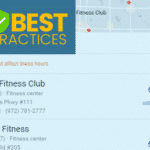Surprised to find out how much writing online content marketing for wellness businesses involves? These reminders help you write to the strengths of your email, social and website channels.
Types of content marketing
Email newsletters
- Create unique content that’s useful, informational, educational, engrossing, interactive
- Write conversationally, not like a marketing robot
- Avoid sounding “salesy” and promotional
- Use images and videos to increase attention and engagement
- Monthly is sufficient for both consumer and corporate wellness businesses
“Five Foods You Thought Were Bad That Aren’t”
Email promotions
- Use copy that’s short, sweet and to the point
- Use persuasive writing techniques and focus on benefits and payoffs
- Include a clear next step or call-to-action
- Include a single relevant and attention-getting image
- Frequency varies wildly by business – but beware of list fatigue
- Twice/monthly is usually the max; once/monthly is often better
“RSVP by Sat., 5/4 to reserve your spot in the Mediterranean Diet In Minutes workshop”
Blog posts
- This format is best for longer content like multi-paragraph features, checklists and case studies
- Good content choices include real-life stories, reflections and how-to’s
- Include your spin on the topic if you post about current popular headlines
- Weekly or monthly when you have something meaningful to say
“Latest Med Diet Research – What It Means For Women”
- Write short, casual posts that invite engagement
- Use open-ended questions that invite responses
- Request that followers take action (“like” this if you love this recipe!)
- Use images and videos to maximize interest and attention
- Post daily or weekly for maximum consumer engagement
- Usually less valuable for corporate wellness and other B2B marketing to employers
“Which dark chocolate should I try next – suggestions, y’all?”
- Every word counts, so use an attention-grabbing lead
- But…consider your audience: will they instantly know what “ICYMI” or +1 or SMH means?
- Best for links to newsletter articles, blog posts or other original content
- Also good for last-minute reminders like “special pricing ends Saturday”
- Avoid “me too” retweets of popular headlines unless you have a fresh spin on it
- Use hashtags like #activeaging to help folks zero in on specific topics
- Post when you have something valuable to say – daily or weekly or twice-monthly
“My kinda diet…lots of wine! #MedMonth” [and include link to Med Diet post, above]
- Short, crisp, usually more formal/professional in tone than, say, Facebook
- Lead with key point
- Include link to full content on your site or a third-party site
- Post daily, weekly or twice-monthly
“What I told the NYT today re: Med diet findings” [include link to article on New York Times website]
Website
- Write like you’re talking to your clients and customers
- Focus on the topics that most interest potential customers – myths, misconceptions, pricing, case studies, program details, etc.
- Plenty of white space so it works well on phones and tablets
- Photos of real customers who accurately represent your typical clients
- Update weekly, bi-weekly or monthly



